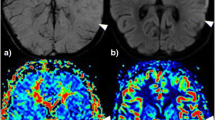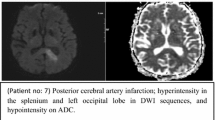Abstract
Introduction
We analyzed the imaging features of transient focal lesions in the splenium of the corpus callosum (SCC) in non-epileptic patients receiving antiepileptic drugs (AEDs).
Methods
We identified signal abnormalities in the SCC in three non-epileptic patients, all of them receiving AEDs. We examined two of these patients with multiplanar magnetic resonance (MR) imaging using 1.0-T equipment including fluid-attenuated inversion recovery (FLAIR), T2-weighted (TSE) and T1-weighted (SE) sequences before and after injection of contrast agent. The third patient was studied using 1.5-T equipment with the same sequences. Additionally, a T1 SE sequence with a magnetization transfer contrast pulse off resonance (T1 SE/MTC), diffusion-weighted imaging (EPI-DWI) and apparent diffusion coefficient (ADC) maps were obtained.
Results
We observed an identical pattern of imaging abnormalities in all patients characterized by round lesions, hyperintense on FLAIR and hypointense on T1 SE images, located in the central portion of the SCC. One lesion showed homogeneous gadolinium enhancement and perilesional vasogenic edema. This particular lesion showed restricted diffusion confirmed on the ADC map. This pattern was considered consistent with focal demyelination. Follow-up MR examinations showed complete disappearance or a clear reduction in lesion size. All patients had been treated with AEDs, but they did not show any clinical signs of toxicity, interhemispheric symptoms, or abnormal neurological findings (including seizures).
Conclusion
We believe that our MR findings might be interpreted as transient lesions related to AED toxicity. They presumably resulted from focal demyelination in the central portion of the SCC.



Similar content being viewed by others
References
Doherty MJ, Jayadev S, Watson NF, et al (2005) Clinical implications of splenium magnetic resonance imaging signal changes. Arch Neurol 62(3):433–437
Tada H, Takanashi J, Barkovich AJ, et al (2004) Clinically mild encephalitis/encephalopathy with a reversible splenial lesion. Neurology 63(10):1854–1858
Takanashi J, Barkovich AJ, Yamaguchi K, et al (2004) Influenza-associated encephalitis/encephalopathy with a reversible lesion in the splenium of the corpus callosum: a case report and literature review. AJNR Am J Neuroradiol 25(5):798–802
Kobata R, Tsukahara H, Nakai A, et al (2002) Transient MR signal changes in the splenium of the corpus callosum in rotavirus encephalopathy: value of diffusion-weighted imaging. J Comput Assist Tomogr 26(5):825–828
Maeda M, Shiroyama T, Tsukahara H, et al (2003) Transient splenial lesion of the corpus callosum associated with antiepileptic drugs: evaluation by diffusion-weighted MR imaging. Eur Radiol 13(8):1902–1906
Prilipko O, Delavelle J, Lazeyras F, et al (2005) Reversible cytotoxic edema in the splenium of the corpus callosum related to antiepileptic treatment: report of two cases and literature review. Epilepsia 10:1633–1636
Chason D, et al (1996) Transient splenial edema in epilepsy: MR imaging evaluation. Presented at the Annual Meeting of the American Society of neuroradiology; 21–27 June, Seattle, WA
Kim SS, Chang KH, Kim ST, et al (1999) Focal lesion in the splenium of the corpus callosum in epileptic patients: antiepileptic drug toxicity? AJNR Am J Neuroradiol 20(1):125–129
Oster J, Doherty C, Grant PE, et al (2003) Diffusion-weighted imaging abnormalities in the splenium after seizures. Epilepsia 44(6):852–854
Tennison M (1999) Focal lesion in the splenium of the corpus callosum in epileptic patients: antiepileptic drug toxicity? AJNR Am J Neuroradiol 20(1):131–132
Polster T, Hoppe M, Ebner A (2001) Transient lesion in the splenium of the corpus callosum: three further cases in epileptic patients and a pathophysiological hypothesis. J Neurol Neurosurg Psychiatry 70(4):459–463
Hakyemez B, Erdogan C, Yildirim N, et al (2005) Transient splenial lesion of corpus callosum associated with antiepileptic drug: conventional and diffusion-weighted magnetic resonance images. Acta Radiol 7:734–736
Takanashi J, Barkovich AJ, Shiihara T, et al (2006) Widening spectrum of a reversible splenial lesion with transiently reduced diffusion. AJNR Am J Neuroradiol 27:836–838
Henry TR, Drury I, Brunberg JA, et al (1994) Focal cerebral magnetic resonance changes associated with partial status epilepticus. Epilepsia 35(1):35–41
Mirsattari SM, Lee DH, Jones MW, et al (2003) Transient lesion in the splenium of the corpus callosum in an epileptic patient. Neurology 60(11):1838–1841
D’Ambrosio R, Perucca E (2004) Epilepsy after head injury. Curr Opin Neurol 17(6):731–735
Butler WH, Ford GP, Newberne JW (1987) A study of the effects of vigabatrin on the central nervous system and retina of Sprague Dawley and Lister-Hooded rats. Toxicol Pathol 15(2):143–148
Mehta R, Pike G, Enzmann D (1996) Measure of magnetization transfer in multiple sclerosis demyelinating plaques, white matter ischemic lesions, and edema. AJNR Am J Neuroradiol 17(6):1051–1055
Ogura H, Takaoka M, Kishi M, et al (1998) Reversible MR findings of hemolytic uremic syndrome with mild encephalopathy. AJNR Am J Neuroradiol 19(6):1144–1145
Conflict of interest statement
We declare that we have no conflict of interest.
Author information
Authors and Affiliations
Corresponding author
Rights and permissions
About this article
Cite this article
da Rocha, A.J., Reis, F., Gama, H.P.P. et al. Focal transient lesion in the splenium of the corpus callosum in three non-epileptic patients. Neuroradiology 48, 731–735 (2006). https://doi.org/10.1007/s00234-006-0116-x
Received:
Accepted:
Published:
Issue Date:
DOI: https://doi.org/10.1007/s00234-006-0116-x




